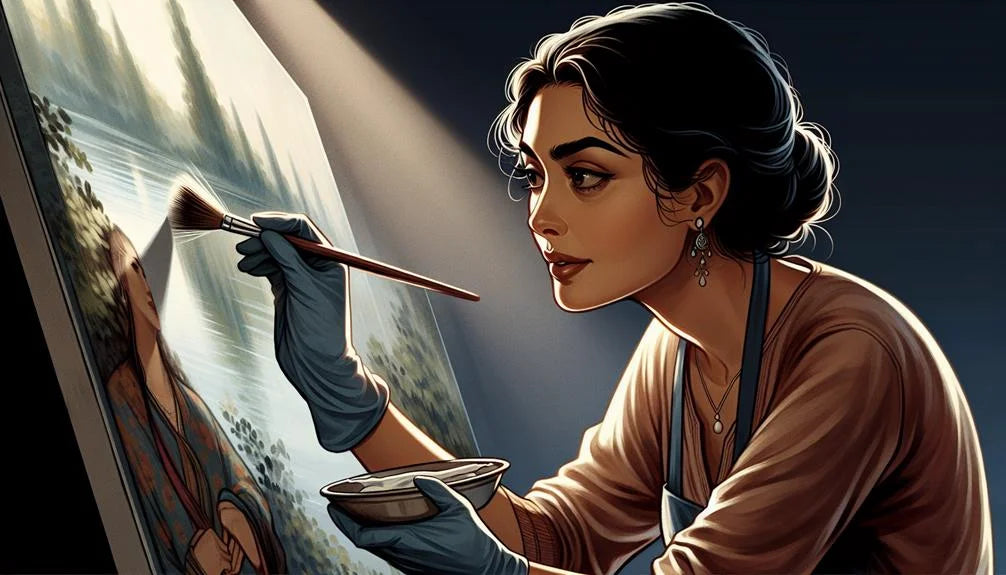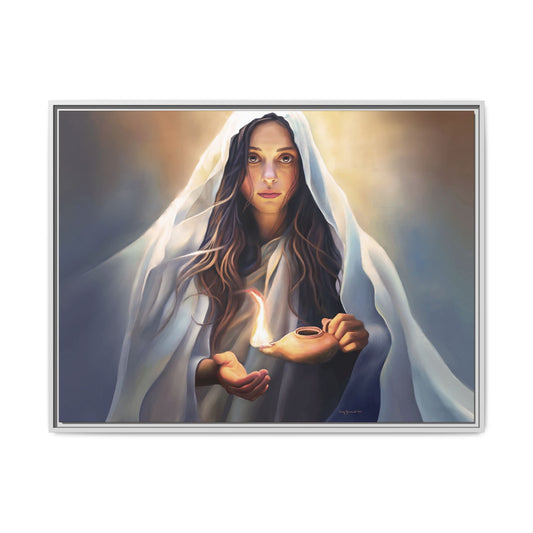
How to Clean an Oil Painting on Canvas
Share
Cleaning an oil painting on canvas is a meticulous process that demands careful attention to detail. Over time, dust, dirt, and grime can accumulate on the surface, affecting the artwork's appearance. But how does one effectively clean an oil painting without compromising its integrity?
The intricacies of this delicate task require a methodical approach and an understanding of the materials involved. By following specific techniques and using the right tools, it's possible to revive the painting's original luster and ensure its longevity.
But what are these techniques, and what considerations should be kept in mind? Let's explore the art of cleaning an oil painting on canvas with precision and care.
Key Takeaways
- It is important to have the necessary supplies for cleaning an oil painting on canvas, including Q-tips, cotton wool balls, distilled water, dishwashing liquid, turpentine, and isopropyl alcohol.
- Before cleaning the painting, remove it from its frame and conduct a thorough inspection for loose or flaking paint. It is also important to ensure a well-ventilated work area and take photographs of the painting before cleaning.
- Gentle dusting and surface cleaning can be done using a soft cloth and soapy water, preferably with an olive oil-based soap with a low pH level. Avoid cleaning agents containing alcohol and gently blot the painting to assess dirt removal. Cotton buds can be used for corners or textured areas with dirt buildup.
- When dealing with stubborn stains and grime, be cautious with dry paint and test the cleaning solution on a small area before applying it to the entire canvas. Seek professional cleaning services for persistent stains or extensive grime. After cleaning, allow the painting to rest upright and consider applying a thin layer of varnish if it appears dry.
Necessary Supplies for Cleaning
What supplies are necessary for cleaning an oil painting on canvas?
Gather the following supplies in order to proceed with the cleaning process: Q-tips, cotton wool balls, distilled water, dishwashing liquid, turpentine, and isopropyl alcohol.
When addressing the task of cleaning oil paintings, it is crucial to be meticulous in the choice of cleaning agents and tools. The surface of an oil painting is delicate and requires careful handling to ensure that the paint and brush strokes remain intact.
Begin by preparing a gentle cleaning solution using soapy water, ensuring that the soap is free from any harsh chemicals that could potentially damage the paint. Dip a soft cloth into the soapy water and gently dab the surface of the painting to lift any accumulated dirt.
For more stubborn blemishes, seek the expertise of an art restorer to prevent any inadvertent damage.
When employing the use of turpentine and isopropyl alcohol, it is imperative to exercise caution and utilize these agents sparingly, as they can potentially dissolve the paint if used excessively.
Preparing the Painting for Cleaning
Before commencing the process of preparing the painting for cleaning, it is essential to carefully remove the artwork from its frame, ensuring gentle handling to avoid any potential damage to the delicate surface of the canvas and paint. Once the painting is removed from the frame, a thorough inspection should be conducted to identify any loose or flaking paint. It is important to take note of any areas that require particular attention during the cleaning process. Additionally, ensure that the work area is well-ventilated and free from any potential hazards that could damage the painting during cleaning.
Taking photographs of the painting before cleaning is highly recommended as it helps to document its condition and serves as a reference during the cleaning process. This step is particularly crucial for valuable or sentimentally significant original oil paintings. If in doubt about the appropriate cleaning methods or if the painting holds significant value, consulting a professional art restorer before attempting to clean it is advised.
In the next step, the surface of the painting can be gently cleaned to remove dust and dirt. This can be done using a soft brush or a damp cloth, depending on the level of dirt accumulation. Stubborn dirt or grime may require the use of a bristle brush, but caution must be exercised to avoid damaging the paint layers.
Gentle Dusting and Surface Cleaning
When embarking on the process of gentle dusting and surface cleaning for an oil painting on canvas, the careful selection of cleaning materials and methods is pivotal to preserving the integrity of the artwork.
It's important to use a soft cloth and soapy water to gently remove a thin layer of dust, grime, or residue from the surface of the oil painting. Consider using an olive oil-based soap with a low pH level and mild properties for effective cleaning without damaging the paint. Avoid using any cleaning agents that contain alcohol, as they could potentially harm the paint.
Gently blot the painting with a damp cloth to assess the amount of dirt being removed, and use cotton buds for corners or textured areas with built-up dirt. Seek professional assistance for a thorough cleaning if the painting has been exposed to the elements or smoke, and avoid scrubbing too hard to prevent potential damage to the paint.
Addressing Stubborn Stains and Grime
Efficiently addressing stubborn stains and grime on an oil painting requires a meticulous approach and an understanding of the appropriate cleaning solutions and techniques.
When dealing with dry paint, it's crucial to be extra careful as incorrect cleaning can cause permanent damage to the surface of your oil painting. Begin by using a mild cleaning solution and gently applying it to the affected area with a soft brush or cotton swab, using a back-and-forth motion. Prior to applying the solution to the entire canvas, it's important to test it on a small, inconspicuous area.
If stubborn stains persist or extensive grime remains, consider seeking professional cleaning services to ensure the preservation of the painting.
After addressing the stains and grime, allow the painting to rest upright for a week or two. If the painting appears dry after cleaning, apply a thin layer of the same varnish previously used to protect the surface.
Ensuring Proper Drying and Care
To ensure the proper drying and care of an oil painting, it is essential to follow certain steps and guidelines:
Allow the painting to dry completely:
After completing a painting, it's crucial to let it dry thoroughly. New pieces can take anywhere from six months to a year to dry completely, depending on the thickness of the paint layers. It's a good practice to hang the painting in a well-ventilated area with consistent temperature and humidity levels to ensure proper drying and preservation.
Store the painting in a suitable environment:
It's important to store the painting in a well-ventilated area with consistent temperature and humidity levels to ensure proper drying and preservation. Extreme temperatures and direct sunlight should be avoided during the drying process to prevent cracking or warping.
Handle with caution:
During the drying period, it's essential to use caution when handling the painting to prevent accidental damage to the soft, wet paint surface.
Seek professional guidance if uncertain:
If uncertain about the proper drying process, seeking guidance from a professional art restorer is advisable to ensure the painting's preservation.
Frequently Asked Questions
What Do I Use to Clean an Oil Painting?
To clean an oil painting, use gentle solvents and mild detergents with a delicate technique. Employ soft brushes with natural bristles to ensure artistic preservation. For thorough restoration, seek professional restoration experts who specialize in conservation methods for oil painting care.
What Is the Best Way to Clean a Canvas Painting?
When considering the best way to clean a canvas painting, it's vital to employ gentle techniques and specialized tools to ensure preservation. Whether opting for professional services or DIY solutions, prioritizing preventative care and conservation principles is essential for artistic maintenance.
How Do You Remove Grime From an Old Oil Painting?
Gentle restoration of an old oil painting involves delicate brushwork and professional conservation to preserve the patina and artistic integrity. Using specialized techniques, remove surface grime and aging varnish to safeguard the artwork's artistic heritage.
Can You Use Murphy's Oil Soap to Clean Oil Paintings?
Murphy's Oil Soap is safe for cleaning oil paintings when diluted with water. However, alternative gentle solvents and professional restoration may be preferred. DIY cleaning techniques must prioritize preserving delicate pigments and understanding varnish to prevent damage, incorporating art conservation techniques.
Conclusion
In conclusion, cleaning an oil painting on canvas requires careful preparation and gentle techniques to avoid damaging the artwork. It is important to use mild soap and avoid harsh chemicals, as well as seek professional help for thorough cleaning or restoration.
According to a survey conducted by the International Institute for Conservation, 60% of oil paintings are damaged due to improper cleaning methods, highlighting the need for cautious and informed cleaning practices.




